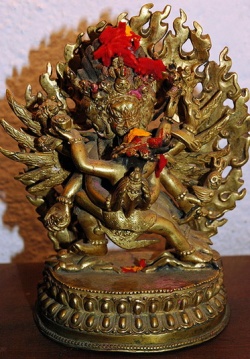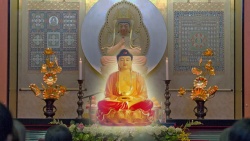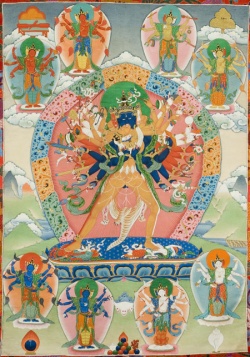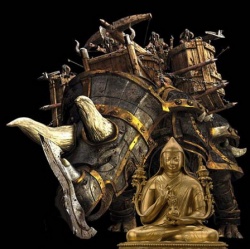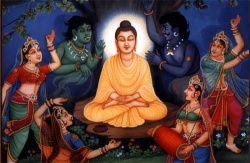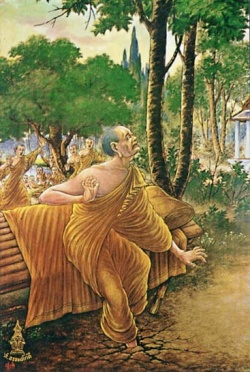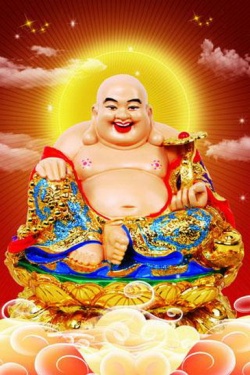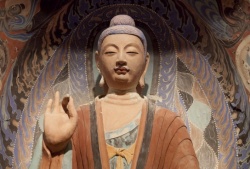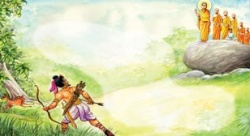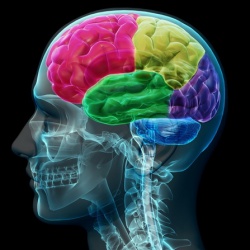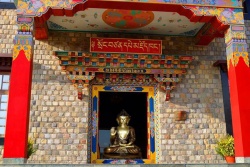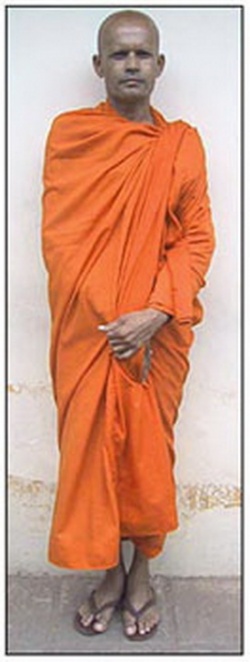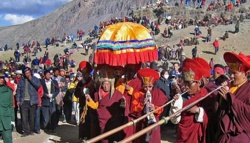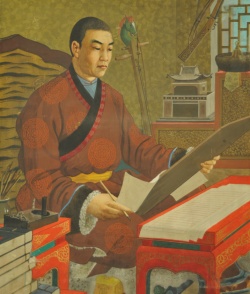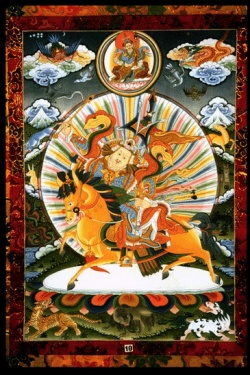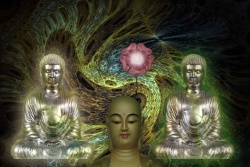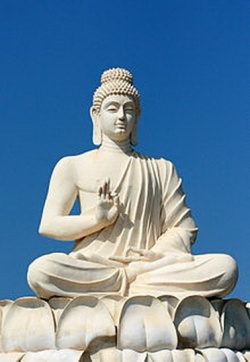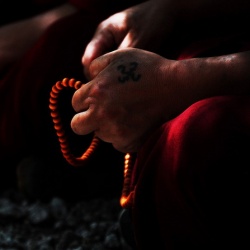Difference between revisions of "Vajrakilaya (also known as Vajrakumara)"
| (4 intermediate revisions by the same user not shown) | |||
| Line 1: | Line 1: | ||
| − | [[File:Vajraklaya-145.jpg|thumb|250px|]] | + | {{SeealsoDPL/button}} |
| + | [[File:Vajraklaya-145.jpg|thumb|250px|]]<nomobile>{{DisplayImages|4000|1117|2074|3405|1539|198|790|3404|933|1981}}</nomobile><nomobile>{{DisplayImages|2486|263|4544|3526|1057|4282|947|1591|1421}}</nomobile> | ||
| Line 6: | Line 7: | ||
[[Vajrakilaya]] (also known as [[Vajrakumara]]) is the [[deity]] of the [[magic]] thundernail, the [[kīla]], a tool of the sharp [[adamantine]] point of [[dharmakaya]], a [[wisdom]] forded through the power of [[one-pointed concentration]]. | [[Vajrakilaya]] (also known as [[Vajrakumara]]) is the [[deity]] of the [[magic]] thundernail, the [[kīla]], a tool of the sharp [[adamantine]] point of [[dharmakaya]], a [[wisdom]] forded through the power of [[one-pointed concentration]]. | ||
| − | This '[[one-pointed]]' ([[Sanskrit]]: [[eka graha]]) focus is a concerted [[mindfulness]] on the unity and [[interdependence]] of all [[dharmas]]. | + | This '[[one-pointed]]' ([[Sanskrit]]: [[eka graha]]) focus is a concerted [[mindfulness]] on the {{Wiki|unity}} and [[interdependence]] of all [[dharmas]]. |
| − | This one-pointed focus is understood as 'applying oneself fully' ([[Tibetan]]: [[sgrim pa]]). | + | This [[one-pointed]] focus is understood as '[[applying oneself fully]]' ([[Tibetan]]: [[sgrim pa]]). |
[[Vajrakilaya]] is a favoured [[tantric]] {{Wiki|archetypal}} [[deity]] embraced by the [[Nyingmapa]]. | [[Vajrakilaya]] is a favoured [[tantric]] {{Wiki|archetypal}} [[deity]] embraced by the [[Nyingmapa]]. | ||
| Line 25: | Line 26: | ||
Both the higher and lower [[activities]] are engaged in, first {{Wiki|concentrating}} on [[recognizing]] the [[mandala]] of [[Vajrakilaya]] by way of [[mantra recitation]] and [[visualization]]. | Both the higher and lower [[activities]] are engaged in, first {{Wiki|concentrating}} on [[recognizing]] the [[mandala]] of [[Vajrakilaya]] by way of [[mantra recitation]] and [[visualization]]. | ||
| − | The lower [[activity]] then invokes the deity’s liberating [[energy]] in a very [[wrathful]] aspect in order to bring about the [[transformation]] of negativity for ourselves and the {{Wiki|community}} at large. | + | The lower [[activity]] then invokes the [[deity’s]] liberating [[energy]] in a very [[wrathful]] aspect in order to bring about the [[transformation]] of negativity for ourselves and the {{Wiki|community}} at large. |
| Line 33: | Line 34: | ||
[[Vajrakilaya's]] three right hands except for the right front one held [[vajras]] with five and nine prongs. The right front one makes a [[mudra]] as granting boons with open palm. | [[Vajrakilaya's]] three right hands except for the right front one held [[vajras]] with five and nine prongs. The right front one makes a [[mudra]] as granting boons with open palm. | ||
| − | [Vajrakilaya's]] three left hands hold a flaming triple wishfulfilling [[jewel]] or [[triratna]], a trident and the [[kilaya]]. | + | [[[Vajrakilaya's]]]] three left hands hold a flaming triple wishfulfilling [[jewel]] or [[triratna]], a [[trident]] and the [[kilaya]]. |
| − | [[Vajrakilaya's]] back is covered by the freshly flayed {{Wiki|skin}} of the [[elephant]] representing '[[ignorance]]' ([[Sanskrit]]: [[avidya]]; Wylie: marigpa), with the {{Wiki|legs}} tied in front. | + | [[Vajrakilaya's]] back is covered by the freshly flayed {{Wiki|skin}} of the [[elephant]] representing '[[ignorance]]' ([[Sanskrit]]: [[avidya]]; [[Wylie]]: [[marigpa]]), with the {{Wiki|legs}} tied in front. |
| − | A [[human]] {{Wiki|skin}} is tied diagonally across his {{Wiki|chest}} with the hands lying flat on [[Vajrakilaya's]] stomach and solar plexus representing the flailed [[ego]] that has released its {{Wiki|powerful}} [[grip]] {{Wiki|obscuring}} the 'qualities' of the [[Sadhaka]]. | + | A [[human]] {{Wiki|skin}} is tied diagonally across his {{Wiki|chest}} with the hands {{Wiki|lying}} flat on [[Vajrakilaya's]] {{Wiki|stomach}} and [[solar plexus]] representing the flailed [[ego]] that has released its {{Wiki|powerful}} [[grip]] {{Wiki|obscuring}} the 'qualities' of the [[Sadhaka]]. |
| − | Qualities are represented iconographically by the 'vortex' (Sanrkit: [[chakra]]; Wylie: [[Khorlo]]) of the [[Manipura]] ([[Sanskrit]]: Maṇipūra). | + | Qualities are represented iconographically by the 'vortex' (Sanrkit: [[chakra]]; [[Wylie]]: [[Khorlo]]) of the [[Manipura]] ([[Sanskrit]]: [[Maṇipūra]]). |
| − | A rope ripples over his [[body]] with severed heads hanging by their [[hair]] representing the [[Akshamala]] or 'garland of [[bija]]' ([[Sanskrit]]: Varnamala). | + | A rope ripples over his [[body]] with severed heads hanging by their [[hair]] representing the [[Akshamala]] or '[[garland]] of [[bija]]' ([[Sanskrit]]: [[Varnamala]]). |
| − | A knee length loin cloth winds around his belly belted with a {{Wiki|tiger}} {{Wiki|skin}} complete with tail, claws and head. This [[deity]] wears manifold [[nāga]] adornments and jewellery: | + | A knee length loin cloth [[winds]] around his belly belted with a {{Wiki|tiger}} {{Wiki|skin}} complete with tail, claws and head. This [[deity]] wears manifold [[nāga]] adornments and jewellery: |
| − | [[naga]] earrings, [[naga]] bracelets, [[naga]] anklets and a [[naga]] cord over his {{Wiki|chest}}, sometimes referred to as a [[naga]] gurdle and a [[naga]] hairpiece or [[hair]] ornament. Vajrakilaya's faces are round and small compared to the tall [[body]]. | + | [[naga]] earrings, [[naga]] bracelets, [[naga]] anklets and a [[naga]] [[Wikipedia:Rope|cord]] over his {{Wiki|chest}}, sometimes referred to as a [[naga]] gurdle and a [[naga]] hairpiece or [[hair]] ornament. [[Vajrakilaya's]] faces are round and small compared to the tall [[body]]. |
| − | Despite the large fangs and bulging [[eyes]] and his [[wrathful]] appearance, [[Vajrakilaya]] is [[perceived]] as having a {{Wiki|benevolent}} demeanor. | + | Despite the large fangs and bulging [[eyes]] and his [[wrathful]] [[appearance]], [[Vajrakilaya]] is [[perceived]] as having a {{Wiki|benevolent}} demeanor. |
[[Vajrakilaya]] is a [[wrathful]] [[manifestation]] of [[Vajrasattva]], the [[buddha]] of [[purification]]. The practice of [[Vajrakilaya]] focuses on removing intense inner and outer {{Wiki|obstacles}} to [[peace]], [[happiness]], and [[enlightenment]]. | [[Vajrakilaya]] is a [[wrathful]] [[manifestation]] of [[Vajrasattva]], the [[buddha]] of [[purification]]. The practice of [[Vajrakilaya]] focuses on removing intense inner and outer {{Wiki|obstacles}} to [[peace]], [[happiness]], and [[enlightenment]]. | ||
| − | In today’s difficult times, anxieties about our personal [[life]] and [[world]] [[conditions]] can create {{Wiki|disturbing}} thought-forms within us. With billions of [[people]] consumed by the same concerns, our shared thought-forms create an interwoven web of great turmoil around the [[world]]. This can give rise to [[afflictive emotions]], creating inner {{Wiki|obstacles}} to [[spiritual]] practice and [[happiness]], which, in turn, [[manifest]] as outer {{Wiki|obstacles}} in [[life]]. [[Vajrakilaya]] practice is especially helpful and suitable during this [[time]], both for {{Wiki|individual}} practitioners and for the well-being of the [[world]] {{Wiki|community}} as a whole. And it is a perfect way to prepare for the New Year. | + | In today’s difficult times, anxieties about our personal [[life]] and [[world]] [[conditions]] can create {{Wiki|disturbing}} [[thought-forms]] within us. With billions of [[people]] consumed by the same concerns, our shared [[thought-forms]] create an interwoven web of great turmoil around the [[world]]. This can give rise to [[afflictive emotions]], creating inner {{Wiki|obstacles}} to [[spiritual]] practice and [[happiness]], which, in turn, [[manifest]] as outer {{Wiki|obstacles}} in [[life]]. [[Vajrakilaya]] practice is especially helpful and suitable during this [[time]], both for {{Wiki|individual}} practitioners and for the well-being of the [[world]] {{Wiki|community}} as a whole. And it is a {{Wiki|perfect}} way to prepare for the New Year. |
| − | “[[Drubchen]]” means “great [[accomplishment]]” in [[Tibetan]] and is one of the most elaborate [[forms]] of [[Vajrayana]] [[Buddhist practice]]. A [[drubchen]] is a rare opportunity to [[concentrate]] [[body]], [[speech]], and [[mind]] in [[spiritual]] application, resulting in [[realization]] and [[merit]] to sustain [[spiritual]] development in this and future [[lives]]. Sincere participation in a [[drubchen]] is said to generate [[merit]] and potential [[realization]] {{Wiki|equal}} to one year of [[retreat]]. Dedicating the practice to all [[sentient beings]] extends this [[benefit]] and enhances [[world]] [[peace]] and {{Wiki|prosperity}}. | + | “[[Drubchen]]” means “great [[accomplishment]]” in [[Tibetan]] and is one of the most elaborate [[forms]] of [[Vajrayana]] [[Buddhist practice]]. A [[drubchen]] is a rare opportunity to [[concentrate]] [[body]], [[speech]], and [[mind]] in [[spiritual]] application, resulting in [[realization]] and [[merit]] to sustain [[spiritual]] [[development]] in this and {{Wiki|future}} [[lives]]. Sincere participation in a [[drubchen]] is said to generate [[merit]] and potential [[realization]] {{Wiki|equal}} to one year of [[retreat]]. Dedicating the practice to all [[sentient beings]] extends this [[benefit]] and enhances [[world]] [[peace]] and {{Wiki|prosperity}}. |
The [[Vajrakilaya]] [[empowerment]] will be given the first morning, but is not required to participate in the [[drubchen]], and no prior [[experience]] in the practice is necessary. You may attend part or all of the [[drubchen]] as your schedule permits, and the [[empowerment]] may be attended separately from the [[drubchen]]. | The [[Vajrakilaya]] [[empowerment]] will be given the first morning, but is not required to participate in the [[drubchen]], and no prior [[experience]] in the practice is necessary. You may attend part or all of the [[drubchen]] as your schedule permits, and the [[empowerment]] may be attended separately from the [[drubchen]]. | ||
| − | [[Vajrakilaya]] is a [[deity]] of the [[Highest]] [[Yoga Tantra]], [[symbolic]] of the [[Activity]] of all [[Enlightened]] [[Beings]]. It is considered to be one of the most {{Wiki|powerful}} practices to overcome [[delusion]], negativity and {{Wiki|obstacles}}. Outwardly, [[Vajrakilaya]] has a [[wrathful]] appearance, but inwardly, [[emanates]] [[great compassion]] for all [[beings]]. In another level of [[tantra]], [[Vajrakilaya]] [[manifests]] as the [[Bodhisattva]] [[Vajrapani]]. | + | [[Vajrakilaya]] is a [[deity]] of the [[Highest]] [[Yoga Tantra]], [[symbolic]] of the [[Activity]] of all [[Enlightened]] [[Beings]]. It is considered to be one of the most {{Wiki|powerful}} practices to overcome [[delusion]], negativity and {{Wiki|obstacles}}. Outwardly, [[Vajrakilaya]] has a [[wrathful]] [[appearance]], but inwardly, [[emanates]] [[great compassion]] for all [[beings]]. In another level of [[tantra]], [[Vajrakilaya]] [[manifests]] as the [[Bodhisattva]] [[Vajrapani]]. |
| − | Many great [[Tibetan]] [[masters]] of all the [[lineages]], especially [[Nyingma]] and [[Sakya]], have engaged in this quintessential practice to accomplish full [[enlightenment]] throughout the ages. The continuous [[transmission]] of this [[Tantra]] comes from these great [[lamas]] in an unbroken [[lineage]] until the present day. | + | Many great [[Tibetan]] [[masters]] of all the [[lineages]], especially [[Nyingma]] and [[Sakya]], have engaged in this quintessential practice to accomplish full [[enlightenment]] throughout the ages. The continuous [[transmission]] of this [[Tantra]] comes from these great [[lamas]] in an unbroken [[lineage]] until the {{Wiki|present}} day. |
This [[Vajrakilaya]] [[blessing]], complemented by positive [[thoughts]] and [[deeds]], creates favorable [[conditions]] to remove difficulties and {{Wiki|increases}} [[merit]] and [[wisdom]] for [[Wikipedia:Absolute (philosophy)|ultimate]] [[realization]]. | This [[Vajrakilaya]] [[blessing]], complemented by positive [[thoughts]] and [[deeds]], creates favorable [[conditions]] to remove difficulties and {{Wiki|increases}} [[merit]] and [[wisdom]] for [[Wikipedia:Absolute (philosophy)|ultimate]] [[realization]]. | ||
| Line 66: | Line 67: | ||
[[Vajrakilaya]], also called [[Vajrakila]] and [[Dorje]] [[Phurba]], is a [[wrathful]] [[Tantric]] [[meditation]] [[deity]] whose practices are most often performed by [[disciples]] of the [[Nyingma]] order. | [[Vajrakilaya]], also called [[Vajrakila]] and [[Dorje]] [[Phurba]], is a [[wrathful]] [[Tantric]] [[meditation]] [[deity]] whose practices are most often performed by [[disciples]] of the [[Nyingma]] order. | ||
| − | [[Vajrakilaya's]] practices are particularly effective methods for removing {{Wiki|obstacles}} and obstructions, and for destroying and purifying negative forces. | + | [[Vajrakilaya's]] practices are particularly effective [[methods]] for removing {{Wiki|obstacles}} and obstructions, and for destroying and purifying negative forces. |
| − | [[Vajrakilaya]] [[embodies]] the {{Wiki|powerful}} [[enlightened]] [[activity]] of all the [[Buddhas]], and his special emblem - the [[ritual]] [[phurba]] dagger - represents the sharp point of [[wisdom]] fixed immobile on [[emptiness]] through the power of [[single-pointed]] [[concentration]]. | + | [[Vajrakilaya]] [[embodies]] the {{Wiki|powerful}} [[enlightened]] [[activity]] of all the [[Buddhas]], and his special {{Wiki|emblem}} - the [[ritual]] [[phurba]] [[dagger]] - represents the sharp point of [[wisdom]] fixed immobile on [[emptiness]] through the power of [[single-pointed]] [[concentration]]. |
| Line 76: | Line 77: | ||
| − | Gestures and Attributes | + | Gestures and [[Attributes]] |
| − | [[Vajrakilaya]] has three heads, six arms, and four {{Wiki|legs}}. His two main hands embrace his [[consort]] [[Khorlo Gyedunma]], and hold the [[magic]] [[phurba]] dagger. | + | [[Vajrakilaya]] has three heads, six arms, and four {{Wiki|legs}}. His two main hands embrace his [[consort]] [[Khorlo Gyedunma]], and hold the [[magic]] [[phurba]] [[dagger]]. |
The lower blade of his [[phurba]] represents method or [[skillful means]], and its upper handle represents [[wisdom]]. | The lower blade of his [[phurba]] represents method or [[skillful means]], and its upper handle represents [[wisdom]]. | ||
| Line 94: | Line 95: | ||
[[Vajrakilaya's]] other right hands hold five- and nine-pronged [[vajras]], representing his power and indestructibility. | [[Vajrakilaya's]] other right hands hold five- and nine-pronged [[vajras]], representing his power and indestructibility. | ||
| − | His other left hands hold a flaming triple wishfulfilling [[jewel]], and a trident which [[symbolizes]] his [[abandonment]] of the imprints of the [[delusions]] of the [[three realms]]. | + | His other left hands hold a flaming triple wishfulfilling [[jewel]], and a [[trident]] which [[symbolizes]] his [[abandonment]] of the imprints of the [[delusions]] of the [[three realms]]. |
' | ' | ||
| − | He wears an [[elephant]] {{Wiki|skin}} across his back, showing that he has abandoned the [[ignorance]] of self-grasping. | + | He wears an [[elephant]] {{Wiki|skin}} across his back, showing that he has abandoned the [[ignorance]] of [[self-grasping]]. |
| − | A [[human]] {{Wiki|skin}} is hung diagonally across the front of his [[body]], indicating his conquest of the self-cherishing [[ego]]. | + | A [[human]] {{Wiki|skin}} is hung diagonally across the front of his [[body]], indicating his conquest of the [[self-cherishing]] [[ego]]. |
His loin cloth is made of {{Wiki|tiger}} {{Wiki|skin}}, [[symbolizing]] his [[abandonment]] of [[hatred]], and he wears a long necklace of freshly severed [[human]] heads, representing his [[abandonment]] of ordinary [[appearances]] and conceptions. | His loin cloth is made of {{Wiki|tiger}} {{Wiki|skin}}, [[symbolizing]] his [[abandonment]] of [[hatred]], and he wears a long necklace of freshly severed [[human]] heads, representing his [[abandonment]] of ordinary [[appearances]] and conceptions. | ||
| − | [[Vajrakilaya's consort]], whom he holds in a [[passionate]] embrace, complements his {{Wiki|masculine}} [[skillful]] methods with her {{Wiki|feminine}} [[wisdom]]. | + | [[Vajrakilaya's consort]], whom he holds in a [[passionate]] embrace, complements his {{Wiki|masculine}} [[skillful]] [[methods]] with her {{Wiki|feminine}} [[wisdom]]. |
They each wear crowns adorned with five [[human]] skulls, indicating their [[purification]] of the [[five aggregates]]. [[Khorlo Gyedunma]] holds a [[skullcup]] brimming with the {{Wiki|blood}} of the [[four maras]], [[symbolizing]] her [[experience]] of the [[clear light of bliss]], and her victory over uncontrolled [[death]]. | They each wear crowns adorned with five [[human]] skulls, indicating their [[purification]] of the [[five aggregates]]. [[Khorlo Gyedunma]] holds a [[skullcup]] brimming with the {{Wiki|blood}} of the [[four maras]], [[symbolizing]] her [[experience]] of the [[clear light of bliss]], and her victory over uncontrolled [[death]]. | ||
| Line 122: | Line 123: | ||
There are many [[Terma]] [[Lineages]] of [[Kilaya]]. [[Sakyas]] practice this as [[yidam]] practice, and they have a [[lineage]] that goes back to the [[Nyingma Kama]]. | There are many [[Terma]] [[Lineages]] of [[Kilaya]]. [[Sakyas]] practice this as [[yidam]] practice, and they have a [[lineage]] that goes back to the [[Nyingma Kama]]. | ||
| − | Even some [[Gelukpas]] practice [[Kilaya]]--HH The [[Dalai Lama]] maintains a practice of Lerab Lingpa's [[Yang Nying Pudri]], which is a [[terma]] of [[Kilaya]] practice, and [[Namgyal Monastery]] maintains this practice. [[Karma Kagyupas]] practice [[Kilaya]] as a [[Yidam]], as well. | + | Even some [[Gelukpas]] practice [[Kilaya]]--HH The [[Dalai Lama]] maintains a practice of [[Lerab Lingpa's]] [[Yang Nying Pudri]], which is a [[terma]] of [[Kilaya]] practice, and [[Namgyal Monastery]] maintains this practice. [[Karma Kagyupas]] practice [[Kilaya]] as a [[Yidam]], as well. |
| − | Most [[Karma Kagyu]] three year [[retreats]] will begin with one week of intensive [[Vajrakilaya practice]], to {{Wiki|purify}} and dispel {{Wiki|obstacles}} and repair [[samaya]] breakage. | + | Most [[Karma Kagyu]] three year [[retreats]] will begin with one [[week]] of intensive [[Vajrakilaya practice]], to {{Wiki|purify}} and dispel {{Wiki|obstacles}} and repair [[samaya]] breakage. |
| − | [[Kilaya]] practice is also usually one of the short daily recitation requirements in a [[three year retreat]], regardless of what the "main practice" is, along with daily [[protector]] recitations, [[vows]], [[Chod practice]], [[Sangcho]], [[Surcho]]...... | + | [[Kilaya]] practice is also usually one of the short daily {{Wiki|recitation}} requirements in a [[three year retreat]], regardless of what the "main practice" is, along with daily [[protector]] [[recitations]], [[vows]], [[Chod practice]], [[Sangcho]], [[Surcho]]...... |
| Line 137: | Line 138: | ||
Up to here, the practice can be exactly like [[yidam]]. | Up to here, the practice can be exactly like [[yidam]]. | ||
| − | A [[yidam]] [[deity]] is inseparable from [[bliss]] and [[emptiness]] of all the [[buddhas]] of the three times. That's the main point. | + | A [[yidam]] [[deity]] is [[inseparable]] from [[bliss]] and [[emptiness]] of all the [[buddhas]] of the three times. That's the main point. |
| Line 144: | Line 145: | ||
After reciting the [[deity]] [[mantra]], you [[transform]] into his "crush the bad guys" [[form]] and the [[visualization]] destroys {{Wiki|obstacles}}. | After reciting the [[deity]] [[mantra]], you [[transform]] into his "crush the bad guys" [[form]] and the [[visualization]] destroys {{Wiki|obstacles}}. | ||
| − | Additionally, [[Vajrakilaya]] comes with [[physical]] accessories, like the mighty [[kila]] ([[phurba]]) that you empower and when you have actualized the practice fully you are able to put [[Ghost]] Hunter Adventures out of business by bringing all ghoulies under your command! | + | Additionally, [[Vajrakilaya]] comes with [[physical]] accessories, like the mighty [[kila]] ([[phurba]]) that you [[empower]] and when you have actualized the practice fully you are able to put [[Ghost]] {{Wiki|Hunter}} Adventures out of business by bringing all ghoulies under your command! |
It all depends on your intent and what you are trying to do. If you are trying to realize the [[view]], then the [[deity]] aspect is what you need to do. If you need even more help because of discomfort in your [[body]], bad [[luck]] and all that, then you want to become the mighty [[Phurba]] and incinerate your opponents! (With [[love]] and clarity). | It all depends on your intent and what you are trying to do. If you are trying to realize the [[view]], then the [[deity]] aspect is what you need to do. If you need even more help because of discomfort in your [[body]], bad [[luck]] and all that, then you want to become the mighty [[Phurba]] and incinerate your opponents! (With [[love]] and clarity). | ||
| − | The usual [[dharmaphala]] [[sadhana]] is merely an invocation and [[prayer]]. Maybe you [[visualize]] them in front of you, maybe not. It's [[interesting]] to practice in this gray area between [[deity]] and [[dharmaphala]]. | + | The usual [[dharmaphala]] [[sadhana]] is merely an {{Wiki|invocation}} and [[prayer]]. Maybe you [[visualize]] them in front of you, maybe not. It's [[interesting]] to practice in this gray area between [[deity]] and [[dharmaphala]]. |
It's good to scramble up your divisions and fixed conceptions. If you have a chance to do a [[Vajrayogini]]/[[dharmaphala]] or a [[Vajrakilaya]]/[[dharmaphala]] then do it. | It's good to scramble up your divisions and fixed conceptions. If you have a chance to do a [[Vajrayogini]]/[[dharmaphala]] or a [[Vajrakilaya]]/[[dharmaphala]] then do it. | ||
| Line 162: | Line 163: | ||
[[Dzongsar Khyentse Rinpoche]] on the practice of [[Vajra Kilaya]] | [[Dzongsar Khyentse Rinpoche]] on the practice of [[Vajra Kilaya]] | ||
| − | [[Vajrakilaya]], or [[kila]], means something sharp, and something that pierces--a dagger, basically. | + | [[Vajrakilaya]], or [[kila]], means something sharp, and something that pierces--a [[dagger]], basically. |
| − | A dagger that is so sharp it can pierce anything, while at the same [[time]] [[nothing]] can pierce it. | + | A [[dagger]] that is so sharp it can pierce anything, while at the same [[time]] [[nothing]] can pierce it. |
| − | That is the quality. This sharp and piercing [[energy]] is what is used to practice and out of the many [[infinite]], [[endless]] [[Vajrayana]] methods this happens to be one of most important methods. | + | That is the [[quality]]. This sharp and piercing [[energy]] is what is used to practice and out of the many [[infinite]], [[endless]] [[Vajrayana]] [[methods]] this happens to be one of most important [[methods]]. |
[[Vajrakilaya]] is one of the most popular [[deities]] when it comes to destroying the {{Wiki|obstacles}}. [ | [[Vajrakilaya]] is one of the most popular [[deities]] when it comes to destroying the {{Wiki|obstacles}}. [ | ||
| − | [Guru Rinpoche]] achieved [[enlightenment]] through practicing [[Yangdag Heruka]] but he first practiced [[Vajrakilaya]] to clean, or to clear the {{Wiki|obstacles}}, and then, through that, he practiced the [[rest]] and then achieved whatever he wanted to achieve. | + | [[[Guru Rinpoche]]]] achieved [[enlightenment]] through practicing [[Yangdag Heruka]] but he first practiced [[Vajrakilaya]] to clean, or to clear the {{Wiki|obstacles}}, and then, through that, he practiced the [[rest]] and then achieved whatever he wanted to achieve. |
So, [[Vajrakilaya]] is known for clearing the {{Wiki|obstacles}}. | So, [[Vajrakilaya]] is known for clearing the {{Wiki|obstacles}}. | ||
| Line 188: | Line 189: | ||
[[Vajrakilaya]] is not just a simple [[deity]]. | [[Vajrakilaya]] is not just a simple [[deity]]. | ||
| − | There is a complete [[path]] from the [[ngondro]] to the developing [[meditation]] and completion [[meditation]], everything. It has a complete [[path]] of its own. | + | There is a complete [[path]] from the [[ngondro]] to the developing [[meditation]] and completion [[meditation]], everything. It has a complete [[path]] of its [[own]]. |
There are many [[treasure teachings]] based on [[Vajrakilaya]]. For instance, there are [[treasure teachings]] from [[Jigme Lingpa]], [[Ratna Lingpa]], and [[Nyang-rel Nyima Ozer]]. | There are many [[treasure teachings]] based on [[Vajrakilaya]]. For instance, there are [[treasure teachings]] from [[Jigme Lingpa]], [[Ratna Lingpa]], and [[Nyang-rel Nyima Ozer]]. | ||
| Line 194: | Line 195: | ||
Not only are there [[treasure teachings]], actually there is also the [[Indian]] [[lineage]], just as there is the [[Hevajra Tantra]], there is also a [[Vajrakilaya]] [[Tantra]]. | Not only are there [[treasure teachings]], actually there is also the [[Indian]] [[lineage]], just as there is the [[Hevajra Tantra]], there is also a [[Vajrakilaya]] [[Tantra]]. | ||
| − | [[Jamyang Khyentse Wangpo]], [[His Holiness]] [[Dilgo Khyentse Rinpoche]], [[Dudjom Rinpoche]], almost all the great [[lamas]], especially within the [[Kagyu]] and [[Nyingma tradition]], have each their own [[Vajrakilaya sadhana practice]]. | + | [[Jamyang Khyentse Wangpo]], [[His Holiness]] [[Dilgo Khyentse Rinpoche]], [[Dudjom Rinpoche]], almost all the great [[lamas]], especially within the [[Kagyu]] and [[Nyingma tradition]], have each their [[own]] [[Vajrakilaya sadhana practice]]. |
| − | When we talk about [[Vajrakilaya]], we talk about four kinds of dagger: | + | When we talk about [[Vajrakilaya]], we talk about four kinds of [[dagger]]: |
| − | [[substance]] dagger, | + | [[substance]] [[dagger]], |
| − | [[compassion]] dagger, | + | [[compassion]] [[dagger]], |
| − | [[bodhicitta]] dagger, and | + | [[bodhicitta]] [[dagger]], and |
| − | [[wisdom]] dagger. [[Substance]] dagger, | + | [[wisdom]] [[dagger]]. [[Substance]] [[dagger]], |
we actually make [[purba]], which is the [[substance]]. | we actually make [[purba]], which is the [[substance]]. | ||
| − | We make it with a very special quality of wood or {{Wiki|iron}}, and bless it with the proper [[Puja's]], [[blessings]], [[visualizations]]. | + | We make it with a very special [[quality]] of [[wood]] or {{Wiki|iron}}, and bless it with the proper [[Puja's]], [[blessings]], [[visualizations]]. |
| − | We keep it, and use it mainly to pierce the outer {{Wiki|obstacles}}. [[Compassion]] dagger is basically the practice of [[compassion]], and the [[object]] the dagger has to stab, the [[object]] to stab is [[sentient beings]]. You have to put it onto [[sentient beings]]. | + | We keep it, and use it mainly to pierce the outer {{Wiki|obstacles}}. [[Compassion]] [[dagger]] is basically the practice of [[compassion]], and the [[object]] the [[dagger]] has to stab, the [[object]] to stab is [[sentient beings]]. You have to put it onto [[sentient beings]]. |
| − | And there is [[bodhicitta]] practice, the [[bodhicitta]] dagger, and that is another [[form]] mainly of practicing [[relative]] [[bodhicitta]] and [[Wikipedia:Absolute (philosophy)|ultimate]] [[bodhicitta]] together. We stab this dagger on methods. | + | And there is [[bodhicitta]] practice, the [[bodhicitta]] [[dagger]], and that is another [[form]] mainly of practicing [[relative]] [[bodhicitta]] and [[Wikipedia:Absolute (philosophy)|ultimate]] [[bodhicitta]] together. We stab this [[dagger]] on [[methods]]. |
[[Wisdom]] and method, method is the [[object]]. That's the complicated one. | [[Wisdom]] and method, method is the [[object]]. That's the complicated one. | ||
| − | And then lastly, the most important dagger is the dagger of [[wisdom]]. | + | And then lastly, the most important [[dagger]] is the [[dagger]] of [[wisdom]]. |
| − | That dagger, the [[wisdom]], is the whole [[Ati-yoga]] [[teaching]], such as the [[Dzogchen]] teachings, and this [[wisdom]] is stabbed on [[ignorance]]. This is the fourth. | + | That [[dagger]], the [[wisdom]], is the whole [[Ati-yoga]] [[teaching]], such as the [[Dzogchen]] teachings, and this [[wisdom]] is stabbed on [[ignorance]]. This is [[the fourth]]. |
| Line 225: | Line 226: | ||
It is believed and this is not some ordinary [[human]] being's talk, [[Guru Rinpoche]] himself said, .wherever the [[Vajrakilaya]] [[Puja]] is done, even that site will become [[auspicious]], free from all kinds of outer, inner, and especially inner and secret [[suffering]]. | It is believed and this is not some ordinary [[human]] being's talk, [[Guru Rinpoche]] himself said, .wherever the [[Vajrakilaya]] [[Puja]] is done, even that site will become [[auspicious]], free from all kinds of outer, inner, and especially inner and secret [[suffering]]. | ||
| − | Those who are indirectly or directly connected to [[Vajrakilaya]] for certain, have a {{Wiki|connection}} with [[Vajrakilaya]], and gradually or immediately all {{Wiki|obstacles}} will be dispelled and the [[Wikipedia:Absolute (philosophy)|ultimate]] result, which is the state of [[Vajrasattva]] can be obtained very soon. | + | Those who are indirectly or directly connected to [[Vajrakilaya]] for certain, have a {{Wiki|connection}} with [[Vajrakilaya]], and gradually or immediately all {{Wiki|obstacles}} will be dispelled and the [[Wikipedia:Absolute (philosophy)|ultimate]] result, which is the [[state]] of [[Vajrasattva]] can be obtained very soon. |
________________ | ________________ | ||
| Line 234: | Line 235: | ||
| − | [[Suchness]] is the natural state of all [[phenomena]] | + | [[Suchness]] is the natural [[state]] of all [[phenomena]] |
This is the [[great perfection]] free of [[duality]]. | This is the [[great perfection]] free of [[duality]]. | ||
Such {{Wiki|nature}} is realised through {{Wiki|individual}} [[awareness]], | Such {{Wiki|nature}} is realised through {{Wiki|individual}} [[awareness]], | ||
| Line 254: | Line 255: | ||
And it perfects [[appearance and existence]] as the [[mandala]] of the [[magical net]]. | And it perfects [[appearance and existence]] as the [[mandala]] of the [[magical net]]. | ||
| − | Ema! May all [[sentient beings]] practice this [[yoga]] of the kila: The supreme activity-deity of all [[buddhas]], | + | Ema! May all [[sentient beings]] practice this [[yoga]] of the [[kila]]: The supreme activity-deity of all [[buddhas]], |
With the [retinue] of supreme sons and [[wrathful]] ones. | With the [retinue] of supreme sons and [[wrathful]] ones. | ||
Gaining power over the [[emptiness]] [[life]] of [[samsara]] and [[nirvana]], | Gaining power over the [[emptiness]] [[life]] of [[samsara]] and [[nirvana]], | ||
| Line 268: | Line 269: | ||
--------------------------------------------------------------------------------- | --------------------------------------------------------------------------------- | ||
| − | The [[kīla]] ([[Sanskrit]] {{Wiki|Devanagari}}: कील; IAST: [[kīla]]; [[Tibetan]]: {{BigTibetan|ཕུར་བ}}, Wylie: phur ba, pronunciationThe [[Phurba]] ([[Vajrakilaya]]) [[chakra]] contains the [[essence]], power and protection of [[Vajrakilaya]], the [[wrathful]] [[Buddha]] that clears {{Wiki|obstacles}}, especially those that are related to [[spirits]]. | + | The [[kīla]] ([[Sanskrit]] {{Wiki|Devanagari}}: [[कील]]; IAST: [[kīla]]; [[Tibetan]]: {{BigTibetan|ཕུར་བ}}, [[Wylie]]: [[phur ba]], pronunciationThe [[Phurba]] ([[Vajrakilaya]]) [[chakra]] contains the [[essence]], power and [[protection]] of [[Vajrakilaya]], the [[wrathful]] [[Buddha]] that clears {{Wiki|obstacles}}, especially those that are related to [[spirits]]. |
| − | The [[Phurba]] is a [[ritual]] dagger that represents [[Vajrakilaya]]. | + | The [[Phurba]] is a [[ritual]] [[dagger]] that represents [[Vajrakilaya]]. |
As [[Vajrakilaya]] is a [[wrathful]] and protective [[form]] of [[Guru Rinpoche]], his energies represent the unchangeable and {{Wiki|indestructible}}, which is [[enlightenment]] itself and also eliminates [[ignorance]], [[greed]] and [[hatred]] in the long run. | As [[Vajrakilaya]] is a [[wrathful]] and protective [[form]] of [[Guru Rinpoche]], his energies represent the unchangeable and {{Wiki|indestructible}}, which is [[enlightenment]] itself and also eliminates [[ignorance]], [[greed]] and [[hatred]] in the long run. | ||
| − | As it is the [[energy]] of an [[enlightened being]], the [[chakra]] also has the ability to provide protection as well as [[transforming]] negative [[spirits]] and [[emotions]] into positive ones. between pur-ba and pur-pu, alt. transliterations: | + | As it is the [[energy]] of an [[enlightened being]], the [[chakra]] also has the ability to provide [[protection]] as well as [[transforming]] negative [[spirits]] and [[emotions]] into positive ones. between [[pur-ba]] and [[pur-pu]], alt. transliterations: |
[[phurpa]], | [[phurpa]], | ||
[[phurbu]] or | [[phurbu]] or | ||
| − | [[phurpu]]) is a three-sided peg, stake, knife, or nail like [[ritual]] implement [[traditionally]] associated with Indo-Tibetan [[Buddhism]], [[Bön]], and [[Indian]] {{Wiki|Vedic}} [[traditions]]. The [[kīla]] is associated with the | + | [[phurpu]]) is a three-sided peg, stake, knife, or nail like [[ritual]] implement [[traditionally]] associated with [[Indo-Tibetan]] [[Buddhism]], [[Bön]], and [[Indian]] {{Wiki|Vedic}} [[traditions]]. The [[kīla]] is associated with the |
[[meditational deity]] (Srkt:[[ishtadevata]], Tib. [[yidam]]) [[Vajrakīla]] ( [[वज्रकील]]) or [[Vajrakīlaya]] (Tib. [[Dorje Phurba]]). | [[meditational deity]] (Srkt:[[ishtadevata]], Tib. [[yidam]]) [[Vajrakīla]] ( [[वज्रकील]]) or [[Vajrakīlaya]] (Tib. [[Dorje Phurba]]). | ||
</poem> | </poem> | ||
| + | |||
| + | |||
{{R}} | {{R}} | ||
| − | [ | + | [[Category:Buddhist Terms]] |
[[Category:Vajrakīlaya]] | [[Category:Vajrakīlaya]] | ||
| + | [[Category:Tibetan Buddhism]] | ||
| + | [[Category:Vajrayana]] | ||
Latest revision as of 10:38, 1 November 2023
Click here to see other articles relating to word Vajrakilaya (also known as Vajrakumara)
Vajrakilaya (also known as Vajrakumara) is the deity of the magic thundernail, the kīla, a tool of the sharp adamantine point of dharmakaya, a wisdom forded through the power of one-pointed concentration.
This 'one-pointed' (Sanskrit: eka graha) focus is a concerted mindfulness on the unity and interdependence of all dharmas.
This one-pointed focus is understood as 'applying oneself fully' (Tibetan: sgrim pa).
Vajrakilaya is a favoured tantric archetypal deity embraced by the Nyingmapa.
The awesome and wrathful manifestation of this empty yet apparent deity assists practitioners in clearing the obstructions to realisation.
Vajrakilaya is the primary meditational deity of the Nyingmapa tradition of Vajrayana Buddhism, and the practice undertaken and accomplished by the majority of its great realized masters.
A compassionate expression of the Buddha nature, Vajrakilaya is the wrathful manifestation of Vajrasattva, arising to purify the source of all suffering, which is ignorance.
Particularly known for its reversal of obstacles, this powerful ritual is performed to transform negativity, sickness, and obscurations, bringing about well being and ultimate enlightenment.
Both the higher and lower activities are engaged in, first concentrating on recognizing the mandala of Vajrakilaya by way of mantra recitation and visualization.
The lower activity then invokes the deity’s liberating energy in a very wrathful aspect in order to bring about the transformation of negativity for ourselves and the community at large.
A common manifestation of Vajrakilla has three heads, six arms, and four legs.
Vajrakilaya's three right hands except for the right front one held vajras with five and nine prongs. The right front one makes a mudra as granting boons with open palm.
[[[Vajrakilaya's]]]] three left hands hold a flaming triple wishfulfilling jewel or triratna, a trident and the kilaya.
Vajrakilaya's back is covered by the freshly flayed skin of the elephant representing 'ignorance' (Sanskrit: avidya; Wylie: marigpa), with the legs tied in front.
A human skin is tied diagonally across his chest with the hands lying flat on Vajrakilaya's stomach and solar plexus representing the flailed ego that has released its powerful grip obscuring the 'qualities' of the Sadhaka.
Qualities are represented iconographically by the 'vortex' (Sanrkit: chakra; Wylie: Khorlo) of the Manipura (Sanskrit: Maṇipūra).
A rope ripples over his body with severed heads hanging by their hair representing the Akshamala or 'garland of bija' (Sanskrit: Varnamala).
A knee length loin cloth winds around his belly belted with a tiger skin complete with tail, claws and head. This deity wears manifold nāga adornments and jewellery:
naga earrings, naga bracelets, naga anklets and a naga cord over his chest, sometimes referred to as a naga gurdle and a naga hairpiece or hair ornament. Vajrakilaya's faces are round and small compared to the tall body.
Despite the large fangs and bulging eyes and his wrathful appearance, Vajrakilaya is perceived as having a benevolent demeanor.
Vajrakilaya is a wrathful manifestation of Vajrasattva, the buddha of purification. The practice of Vajrakilaya focuses on removing intense inner and outer obstacles to peace, happiness, and enlightenment.
In today’s difficult times, anxieties about our personal life and world conditions can create disturbing thought-forms within us. With billions of people consumed by the same concerns, our shared thought-forms create an interwoven web of great turmoil around the world. This can give rise to afflictive emotions, creating inner obstacles to spiritual practice and happiness, which, in turn, manifest as outer obstacles in life. Vajrakilaya practice is especially helpful and suitable during this time, both for individual practitioners and for the well-being of the world community as a whole. And it is a perfect way to prepare for the New Year.
“Drubchen” means “great accomplishment” in Tibetan and is one of the most elaborate forms of Vajrayana Buddhist practice. A drubchen is a rare opportunity to concentrate body, speech, and mind in spiritual application, resulting in realization and merit to sustain spiritual development in this and future lives. Sincere participation in a drubchen is said to generate merit and potential realization equal to one year of retreat. Dedicating the practice to all sentient beings extends this benefit and enhances world peace and prosperity.
The Vajrakilaya empowerment will be given the first morning, but is not required to participate in the drubchen, and no prior experience in the practice is necessary. You may attend part or all of the drubchen as your schedule permits, and the empowerment may be attended separately from the drubchen.
Vajrakilaya is a deity of the Highest Yoga Tantra, symbolic of the Activity of all Enlightened Beings. It is considered to be one of the most powerful practices to overcome delusion, negativity and obstacles. Outwardly, Vajrakilaya has a wrathful appearance, but inwardly, emanates great compassion for all beings. In another level of tantra, Vajrakilaya manifests as the Bodhisattva Vajrapani.
Many great Tibetan masters of all the lineages, especially Nyingma and Sakya, have engaged in this quintessential practice to accomplish full enlightenment throughout the ages. The continuous transmission of this Tantra comes from these great lamas in an unbroken lineage until the present day.
This Vajrakilaya blessing, complemented by positive thoughts and deeds, creates favorable conditions to remove difficulties and increases merit and wisdom for ultimate realization.
Vajrakilaya, also called Vajrakila and Dorje Phurba, is a wrathful Tantric meditation deity whose practices are most often performed by disciples of the Nyingma order.
Vajrakilaya's practices are particularly effective methods for removing obstacles and obstructions, and for destroying and purifying negative forces.
Vajrakilaya embodies the powerful enlightened activity of all the Buddhas, and his special emblem - the ritual phurba dagger - represents the sharp point of wisdom fixed immobile on emptiness through the power of single-pointed concentration.
When the great Guru Padmasambhava first arrived in Tibet, the first trasmission that he gave to his twenty-five "heart disciples" were the practices of the Varjakilaya Tantra.
Padmasambhava gave these teachings in order to eliminate obstructions to the propagation of Buddhadharma in Tibet.
Gestures and Attributes
Vajrakilaya has three heads, six arms, and four legs. His two main hands embrace his consort Khorlo Gyedunma, and hold the magic phurba dagger.
The lower blade of his phurba represents method or skillful means, and its upper handle represents wisdom.
The triple-edged nature of the blade symbolizes the severance of the three root delusions of;
hatred,
ignorance, and
desirous attachment,
and its triangular single-pointed shape symbolizes the realization of emptiness.
Vajrakilaya's other right hands hold five- and nine-pronged vajras, representing his power and indestructibility.
His other left hands hold a flaming triple wishfulfilling jewel, and a trident which symbolizes his abandonment of the imprints of the delusions of the three realms.
'
He wears an elephant skin across his back, showing that he has abandoned the ignorance of self-grasping.
A human skin is hung diagonally across the front of his body, indicating his conquest of the self-cherishing ego.
His loin cloth is made of tiger skin, symbolizing his abandonment of hatred, and he wears a long necklace of freshly severed human heads, representing his abandonment of ordinary appearances and conceptions.
Vajrakilaya's consort, whom he holds in a passionate embrace, complements his masculine skillful methods with her feminine wisdom.
They each wear crowns adorned with five human skulls, indicating their purification of the five aggregates. Khorlo Gyedunma holds a skullcup brimming with the blood of the four maras, symbolizing her experience of the clear light of bliss, and her victory over uncontrolled death.
They stand together in the warrior's pose, with one leg bent and the other extended, surrounded by the blazing fire of exalted wisdom which annihilates all delusions and consumes neurotic states.
In Nyingma traditions, Vajrakilaya is seen as the most extreme [[wrathful form of Vajrasattva.
So, if Vajrasattva is the peaceful deity that represents purification, then Vajravidarana is seen as the semi-wrathful form, Vajrapani as the wrathful form, and Vajrakilaya as the extremely wrathful form.
Vajrakilaya is most definitely a yidam.
Nyingmapas often take Vajrakilaya as their first yidam practice, and many maintain it as their main yidam practice.
There are many Terma Lineages of Kilaya. Sakyas practice this as yidam practice, and they have a lineage that goes back to the Nyingma Kama.
Even some Gelukpas practice Kilaya--HH The Dalai Lama maintains a practice of Lerab Lingpa's Yang Nying Pudri, which is a terma of Kilaya practice, and Namgyal Monastery maintains this practice. Karma Kagyupas practice Kilaya as a Yidam, as well.
Most Karma Kagyu three year retreats will begin with one week of intensive Vajrakilaya practice, to purify and dispel obstacles and repair samaya breakage.
Kilaya practice is also usually one of the short daily recitation requirements in a three year retreat, regardless of what the "main practice" is, along with daily protector recitations, vows, Chod practice, Sangcho, Surcho......
As a Yidam, Vajrakilaya has the special talent of destroying any manner of harmful being.
As Vajrakilaya, you are the dharmaphala. The dharmaphala/yidam line can be quite thin.
For example, many dharmaphalas are also buddhas like in a form of vajrayogini, and in some dharmaphala sadhanas you visualize yourself as the dharmaphala and recite the mantra.
Up to here, the practice can be exactly like yidam.
A yidam deity is inseparable from bliss and emptiness of all the buddhas of the three times. That's the main point.
Then when you want to request the four buddha activities you "emanate" the yidam out into the world usually surrounded by all manner of kick ass buddha beings and request them to do their activities. Some Vajrakilayas have this element.
After reciting the deity mantra, you transform into his "crush the bad guys" form and the visualization destroys obstacles.
Additionally, Vajrakilaya comes with physical accessories, like the mighty kila (phurba) that you empower and when you have actualized the practice fully you are able to put Ghost Hunter Adventures out of business by bringing all ghoulies under your command!
It all depends on your intent and what you are trying to do. If you are trying to realize the view, then the deity aspect is what you need to do. If you need even more help because of discomfort in your body, bad luck and all that, then you want to become the mighty Phurba and incinerate your opponents! (With love and clarity).
The usual dharmaphala sadhana is merely an invocation and prayer. Maybe you visualize them in front of you, maybe not. It's interesting to practice in this gray area between deity and dharmaphala.
It's good to scramble up your divisions and fixed conceptions. If you have a chance to do a Vajrayogini/dharmaphala or a Vajrakilaya/dharmaphala then do it.
We are trying to become buddhas who have all these four activities.
We not only want these activities performed on our behalf, but we want to perform them on others behalf as well. Remember, our bodhichitta is not only an aspiration, but also real action.
Dzongsar Khyentse Rinpoche on the practice of Vajra Kilaya
Vajrakilaya, or kila, means something sharp, and something that pierces--a dagger, basically.
A dagger that is so sharp it can pierce anything, while at the same time nothing can pierce it.
That is the quality. This sharp and piercing energy is what is used to practice and out of the many infinite, endless Vajrayana methods this happens to be one of most important methods.
Vajrakilaya is one of the most popular deities when it comes to destroying the obstacles. [
[[[Guru Rinpoche]]]] achieved enlightenment through practicing Yangdag Heruka but he first practiced Vajrakilaya to clean, or to clear the obstacles, and then, through that, he practiced the rest and then achieved whatever he wanted to achieve.
So, Vajrakilaya is known for clearing the obstacles.
Vajrakilaya is also known as being the embodiment of all the Buddha's activities.
At times, when we speak of Vajrakilaya, we speak of Vajrakilaya as if it is the wrathful form of Vajrasattva.
There are many, many great masters both in India and Tibet, but especially in Tibet, who have practiced Vajrakilaya, especially in the Nyingma lineage, and among the Kagyu and also within the Sakyapas . [among the three traditions] the Sakyapa, Tsharpa and Ngorpa.
The Sakyapa's main deity, besides Hevajra, is Vajrakumara or Vajrakilaya. To this day, one of His Holiness Sakya Trizin's main practices is Vajrakilaya.
Vajrakilaya is not just a simple deity.
There is a complete path from the ngondro to the developing meditation and completion meditation, everything. It has a complete path of its own.
There are many treasure teachings based on Vajrakilaya. For instance, there are treasure teachings from Jigme Lingpa, Ratna Lingpa, and Nyang-rel Nyima Ozer.
Not only are there treasure teachings, actually there is also the Indian lineage, just as there is the Hevajra Tantra, there is also a Vajrakilaya Tantra.
Jamyang Khyentse Wangpo, His Holiness Dilgo Khyentse Rinpoche, Dudjom Rinpoche, almost all the great lamas, especially within the Kagyu and Nyingma tradition, have each their own Vajrakilaya sadhana practice.
When we talk about Vajrakilaya, we talk about four kinds of dagger:
substance dagger,
compassion dagger,
bodhicitta dagger, and
wisdom dagger. Substance dagger,
we actually make purba, which is the substance.
We make it with a very special quality of wood or iron, and bless it with the proper Puja's, blessings, visualizations.
We keep it, and use it mainly to pierce the outer obstacles. Compassion dagger is basically the practice of compassion, and the object the dagger has to stab, the object to stab is sentient beings. You have to put it onto sentient beings.
And there is bodhicitta practice, the bodhicitta dagger, and that is another form mainly of practicing relative bodhicitta and ultimate bodhicitta together. We stab this dagger on methods.
Wisdom and method, method is the object. That's the complicated one.
And then lastly, the most important dagger is the dagger of wisdom.
That dagger, the wisdom, is the whole Ati-yoga teaching, such as the Dzogchen teachings, and this wisdom is stabbed on ignorance. This is the fourth.
During the Puja, we definitely try to include all of them, through visualizations, through mantras and through mudras.
It is believed and this is not some ordinary human being's talk, Guru Rinpoche himself said, .wherever the Vajrakilaya Puja is done, even that site will become auspicious, free from all kinds of outer, inner, and especially inner and secret suffering.
Those who are indirectly or directly connected to Vajrakilaya for certain, have a connection with Vajrakilaya, and gradually or immediately all obstacles will be dispelled and the ultimate result, which is the state of Vajrasattva can be obtained very soon.
________________
The great master Mipham Rinpoche [1846-1912] condenses the meaning of Vajrakilaya in the following words:
Suchness is the natural state of all phenomena
This is the great perfection free of duality.
Such nature is realised through individual awareness,
Which is the absolute kila - wisdom of awareness.
[It is called] Vajra as non-dual wisdom is indestructible,
And Kumara [Youth] as this the unchanging nature, free of decay.
This primordially all-pervading buddhanature
Resides as the absolute nature of all beings.
Through the skillful oral advice of the guru's insructions
And through the yoga of realising the natural ground of the intrinsic mind.
The manifestations of samsara and nirvana are brought under control,
Through piercing these phenomena with the kila of awareness.
Thus, the wisdom confidence that destroys [the illusions of] samsara and nirvana,
Steals the life force of the confusion so difficult to tame.
It fills the space of bliss with bodhicitta,
And it perfects appearance and existence as the mandala of the magical net.
Ema! May all sentient beings practice this yoga of the kila: The supreme activity-deity of all buddhas,
With the [retinue] of supreme sons and wrathful ones.
Gaining power over the emptiness life of samsara and nirvana,
May they all achieve the level of the Great Glorious One, in this very life!
Written by the one named Dhi on the twenty-third day in the second month of the Earth Monkey Year.
The kīla (Sanskrit Devanagari: कील; IAST: kīla; Tibetan: ཕུར་བ, Wylie: phur ba, pronunciationThe Phurba (Vajrakilaya) chakra contains the essence, power and protection of Vajrakilaya, the wrathful Buddha that clears obstacles, especially those that are related to spirits.
The Phurba is a ritual dagger that represents Vajrakilaya.
As Vajrakilaya is a wrathful and protective form of Guru Rinpoche, his energies represent the unchangeable and indestructible, which is enlightenment itself and also eliminates ignorance, greed and hatred in the long run.
As it is the energy of an enlightened being, the chakra also has the ability to provide protection as well as transforming negative spirits and emotions into positive ones. between pur-ba and pur-pu, alt. transliterations:
phurpa,
phurbu or
phurpu) is a three-sided peg, stake, knife, or nail like ritual implement traditionally associated with Indo-Tibetan Buddhism, Bön, and Indian Vedic traditions. The kīla is associated with the
meditational deity (Srkt:ishtadevata, Tib. yidam) Vajrakīla ( वज्रकील) or Vajrakīlaya (Tib. Dorje Phurba).
